Column: Abroad in Vietnam, a weekend “A-Hue”
Our time in Vietnam thus far has been unbelievable, but if I am honest, I think this last weekend spent in Hue has been one of my favorite experiences to date. Hue, pronounced “hway,” is a city just a few hours north of Da Nang. It is part of the northern region of Vietnam, while Da Nang is considered part of the south. Due to its placement, Hue was located just south of the demilitarized zone, or DMZ, during the war. The city itself was the site for the Battle of Hue, which according to the U.S. Vietnam War Commemoration, was one of the bloodiest battles that took place during the Vietnam War.
It is such an important place to visit to understand the lasting impacts of the war. Everywhere you go in Hue, the city is reminiscent. It takes an entire weekend to just get a glimpse of all the history.
We began our trip by traveling over what is known as the Hai Van Pass. To get from Da Nang to Hue, you have to go over the mountain that separates the cool northern air from the warmer southern side. Safe to say, it’s a good thing we all brought our jackets. 
Even though the weather drops a bit, the drive itself is beautiful. It is mesmerizing to look out to the city of Da Nang below from the high road above. However, the coolest part certainly happened before we climbed up the mountain. Just below the pass is the beach where U.S. troops were first deployed to South Vietnam on March 8, 1965.
We were there on March 7, just a day before the 60th anniversary of the deployment. It was such a surreal experience to line up our photo of that day with the present moment. What a way to begin the trip.
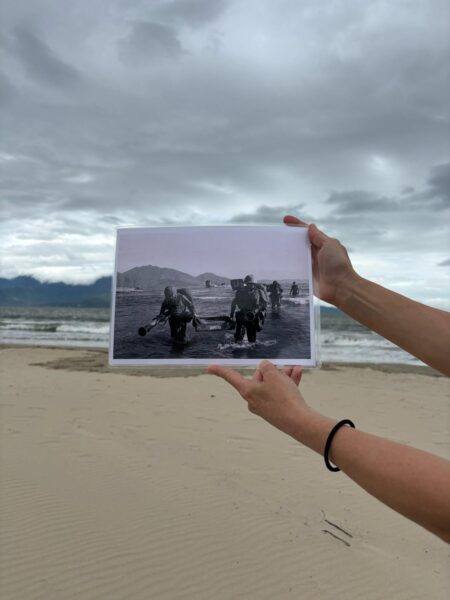
A photo of U.S. soldiers arriving in Da Nang lines up with our tour location. Photo credit: Lily Child
Our first official excursion day was spent touring parts of the Quang Tri province, which is where most of the fighting in the DMZ occurred. We started with the Vinh Moc Tunnels. These tunnels were built during the war as bomb shelters to protect Vietnamese families and people from the harsh U.S. bombing of the DMZ.
You can not only barely stand up on the slippery stone, but without the lights that have been put in so the tunnels can be toured, you wouldn’t be able to see anything at all. Walking down the tall steps and descending into the small caverns below, I couldn’t even imagine what it would be like to call those tunnels home. To hear the sound of bombs and aircraft from above and to feel the earth shake around you would have been terrifying and brutal. It is crazy to think touring these tunnels has become something fun to do when their original purpose couldn’t be further from that feeling.
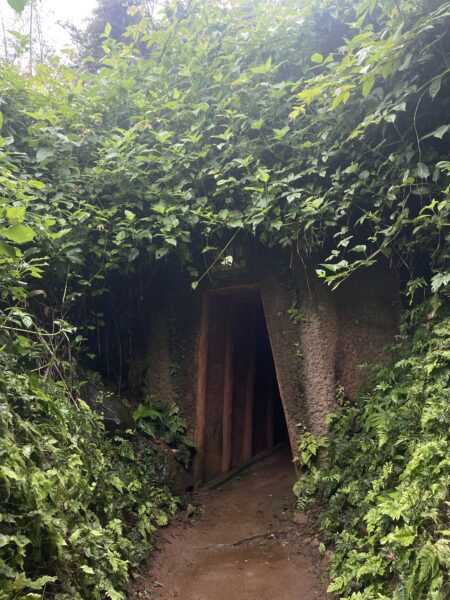
An entrance into the Vinh Moc Tunnels is now overgrown with greenery.
After that, we visited the Quang Tri Mine Action Center, which is an organization dedicated to surveying land and removing unexploded ordinances left over from the war. They report nearly 800,000 tons of the 7.8 million tons of munition dropped on Vietnam failed to detonate, leaving 20% of the country full of unexploded ordinances. Their mission then is to help the communities affected by those ordinances and regain the land that was contaminated because of the war.
In the action center itself, there is a map of all of the bombs dropped by U.S. forces throughout the war. The entire span of Vietnam is covered in tiny red dots, with some areas so heavily covered they are completely colored in. On the other side of the center is a display stand neatly stacked with old prosthetic limbs from people who were injured due to a run-in with an unexploded ordinance.

The group stands in front of our tour guide Phu, who describes the bomb statistics map before us. Photo credit: Jennifer Peeples
The air in the center that day was heavy. My thoughts were heavy. It was a difficult thing to witness but even more difficult to process. I personally feel like we all have a duty to witness this gruesome part of our American history. We do not have to take personal responsibility for things that happened during the war, but I do think we each play a role in helping our country remedy the problems Vietnam faces because of it.
Like I said at the beginning of this trip, nothing is insignificant in the process of peacebuilding, even if that means simply just witnessing what happens when your country drops millions of tons of munitions to fight a war.
After our time in Quang Tri, we spent the next day touring the Thien Mu Pagoda, the Hue Imperial City and the Mausoleum of Emperor Tu Duc. All these locations were breathtaking and full of so much rich history and culture. It is hard to express in words how deeply these locations can resonate with you.
In the Thien Mu Pagoda, the chanting of the monks hums in your chest and reverberates off the walls. The ornate gold decorations of the Hue Imperial City shimmer in the light of every one of your photos. Tu Duc’s poetry pavilion fills you with a sense of peace as koi fish drift beneath you and you imagine the way an emperor might recite poetry. It was fantastical.
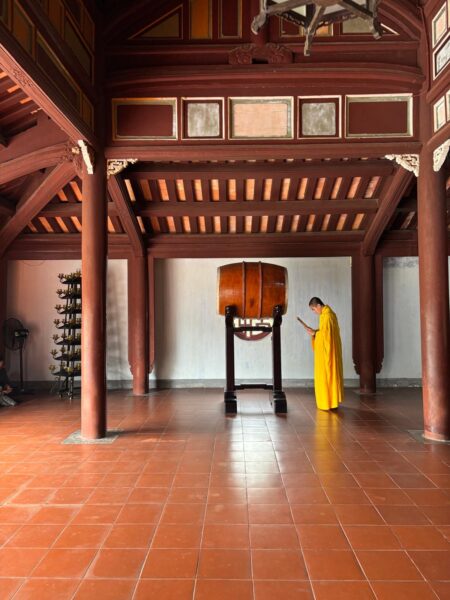
A Buddhist monk prepares to beat a drum at Thien Mu Pagoda. Photo credit: Lily Child
Finally, we finished our trip in Hue with a bike tour of Kim Long Village along the Huong River, where we had the opportunity to speak with local families about their lives and businesses. Very different from the sightseeing of the previous day, we slowed down a little bit and got to know some of the history of the area and the people who live there.
One man spent his time caring for nearly 80 bonsai trees and taught us how to worship using incense. An older woman cared for her ancient home and showed us the ways in which she preserves tradition. Another family exhibited how tourism benefits their community and served us a traditional Vietnamese meal. We also had the opportunity to visit the Huong River Antique Pottery Museum, where we saw ceramics that were anywhere from 2,500–3,000 years old.
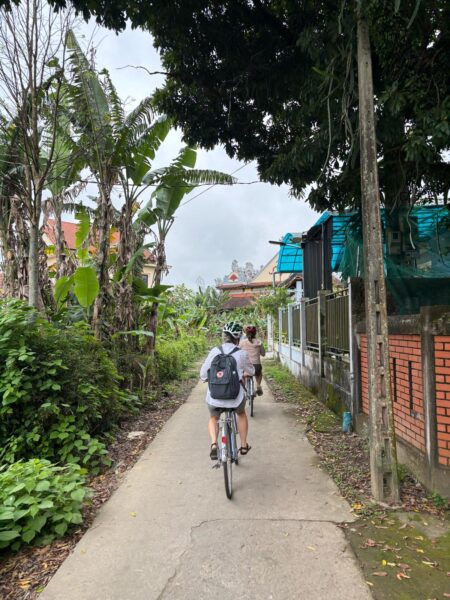
The HPI Vietnam group rides bikes through the village of Kim Long. Photo credit: Lily Child
I cannot express enough to you just how incredible this trip to Hue was. Not only was it beautiful in landscape and experience, but it aided me in connecting the dots between the projects I am working on through my coursework and the place I am calling home for the next few weeks. Being able to see the things you are learning about and connecting with the communities around you is such a unique and beneficial way to experience education.
Oh! And if you’re wondering … yes, I did get crepes and, yes, they were to die for.
You must be logged in to post a comment.

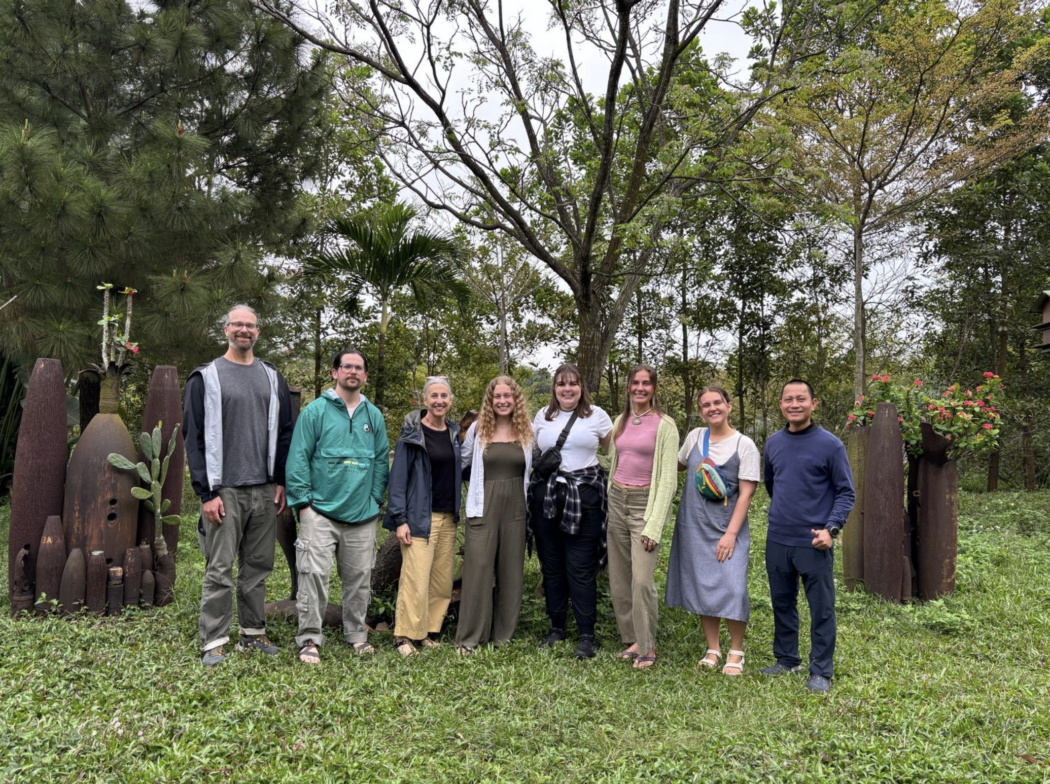
There are no comments
Add yours